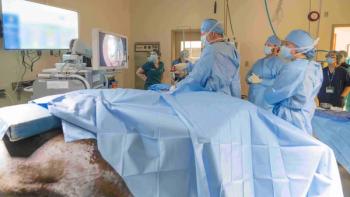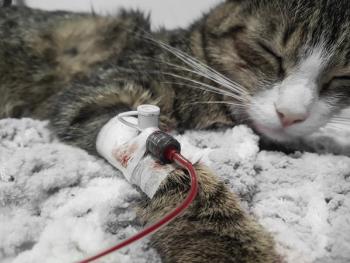
Managing orthopedic infections (Proceedings)
Orthopedic infections should also be thought of as infections involving the bones (osteitis or osteomyelitis), joints and surrounding support structures (periostitis, myelitis, cellulitis). Typically when we think of orthopedic infections we think of infections resulting after orthopedic surgery.
Orthopedic infections should also be thought of as infections involving the bones (osteitis or osteomyelitis), joints and surrounding support structures (periostitis, myelitis, cellulitis). Typically when we think of orthopedic infections we think of infections resulting after orthopedic surgery. Although this can be one of the more common causes of orthopedic infections, it is not the only cause. Sources or routes of infection include open fractures, surgical intervention, puncture wounds from foreign material or bites, direct extension from adjacent soft tissues or hematogenous spread. Bacteria are the most common cause of infection although fungi and viruses can also cause infection.
Acute vs Chronic
Acute infections typically occur within 48-72 hours of surgery or penetrating trauma. These are characterized by localized pain, swelling, erythema and possibly increased body temperature. Radiographic signs other than soft tissue swelling may not be apparent. In the case of a penetrating wound as the source of infection, sq emphysema or actual foreign body may be present. Chronic infections may present with draining tracts, muscle atrophy, fibrosis or contracture; varying degrees of lameness and radiographic changes. A productive periosteal bone response may occur within 7-14 days of an initial insult. This bony response is initially spiculated and irregular in appearance but typically becomes smoother (lamellar) as the lesion becomes chronic or inactive. Radiographic changes resulting from direct inoculation usually consist of a very irregular productive periosteal response. It often has a mottled appearance and a long zone of transition from abnormal to normal bone. A mixed productive/destructive bone response is present within the medullary and cortical bone resulting in disruption of bone architecture and a loss of definition of cortical margins. In chronic cases, a sequestrum may be apparent. This is a dead piece of bone that is well marginated and dense. It may appear within an involcrum, which is an enveloping sheath or membrane of new bone that appears as a central lucent lesion surrounded by a thick rim of irregular sclerotic bone. Joint effusion may be seen if the infection has extended into the joint. With fungal infections, we see the mixed productive/destructive bone response as in bacterial osteomyelitis although it is typically more productive than destructive.
Organisms
Bacteria are the most common cause of infection although fungi and viruses can also cause infection. Staphylococci species make up about 50-60% of orthopedic infections. These include Staph. aureus and Staph. intermedius also called pseudintermedius. Most are resistant to penicilins due to betalactmase production. Better yet, we are seeing more and more methicillin resistant forms of these bacteria (MRSA and MRSI/ MRSP). Other common bacteria include Streptococcus, E.coli, Proteus, Klebsiella, Pseudomonas and Pasteurella. Pasteurella along with anaerobes such as Actinomyces, Clostridium, Peptostreptococcus, Bacteroides and Fusobacterium are common in bite wounds.
Pathophysiology
Healthy bone is typically resistant to infection. Infection usually takes more than just contamination with bacteria. Usually there are one or more underlying factors such as soft tissue trauma which influences perfusion, implants (stainless steel or other), unstable fracture fragments, sequestration or other alterations in tissue defenses such as underlying immunosuppression (iatrogenic steroid use, chemotherapeutics) or metabolic alterations (diabetes, hypothyroid, Cushing's). Metal implants have been shown to create low-grade inflammation that decreases the host's natural defenses. Bacteria are able to produce a biofilm layer or glycocalyx that allows them to grab on to implants or foreign material. This biofilm layer protects them from phagocytosis and antibodies.
Treatment
In today's environment of MRSA's, MRSP's and multidrug resistant organisms, culture and sensitivity is the number one recommendation for basing antibiotic treatment regiments. If possible, cultures should be collected prior to starting antibiotics. Culture samples should not be collected from grossly contaminated areas or superficially from skin or draining tracts. The samples should be collected from areas that have been aseptically prepped, either at the time of surgery in case of open fracture repairs, wound debridements or lavaging of septic joints. If there is no plan for surgical cultures, the wound, draining tract or swollen area should be aseptically prepped prior to culture collection. If possible, aspiration/collection of deeper tissues or fluids should be submitted for culture as superficial fluid/tissue may have multiple contaminants. If you are unable to collect cultures or while pending culture results, the patient should be placed on empirical broad-spectrum antibiotic coverage based on knowledge of common causes of orthopedic infections (see above) or knowledge of common nosocomial infections. Antibiotics are continued for 4-6 weeks. In the case of infected fractures, antibiotics are continued until the fracture has healed, the implants are removed and recultured; antibiotics are continued for an addition 2-4 weeks or until negative culture results return. In the case of acute infections, complete debridement of the wound should be performed, if indicated. If a single joint is involved, copious lavage of the joint under aseptic conditions, such as a surgical suite, is performed to reduce or prevent damage to the articular cartilage. Wounds or draining tracts may need to be debrided and managed as open wounds. In the case of acute infection of fracture repairs, stability of the fracture should be assessed. Fractures can heal in the face of infection if there is appropriate stability, appropriate antibiotic coverage and appropriate medical management. Loose implants should be removed or replaced to provide rigid stabilization. In the case of chronic infections careful evaluation of the bone, joint and surrounding soft tissues is indicated. In the case of fractures, careful assessment of the fracture is made. If the fracture is healed, removal of the implants may be warranted to resolve infection due to the biofilm the bacteria may have formed on the implants. This applies to other nonabsorbable implants such as materials used in extracapsular techniques to stabilize the stifle for cranial cruciate ligament deficiency. Any sequestra identified will need to be removed. If the fracture is not healed (delayed or nonunion), careful assessment of the fracture stabilization technique is made and corrected as needed. Grafting may be indicated either at the initial surgery, revision surgery or as the infection is resolving and wounds healing. Again, implants will need to be removed after the fracture has healed to completely resolve the infection.
Additional reading:
Textbook of Small Animal Surgery, Ed: Douglas Slatter, 3rd edition. Pub. Saunders of Elsevier Science, Philadelphia, 2003
Handbook of Small Animal Orthopedics and Fracture Repair, Ed: D Piermattei, G. Flo, C. DeCamp, 4th edition. Pub. Saunders of Elsevier Science, Philadelphia, 2006
Small Animal Surgery, Ed. T. Fossum, 3rd edition. Pub. Mosby of Elsevier Science, St. Louis, 2007
Newsletter
From exam room tips to practice management insights, get trusted veterinary news delivered straight to your inbox—subscribe to dvm360.




